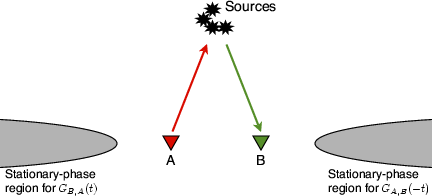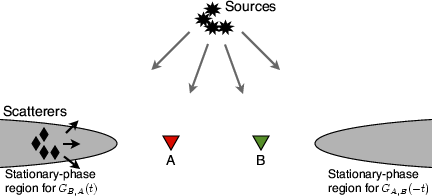|
|
|
|
Kinematics in iterated correlations of a passive acoustic experiment |


|
|---|
|
mainC2drawnew1,mainC2drawnew2
Figure 1. Source positions for respectively (a) high-quality and (b) poor quality Green's function estimation by conventional SI. Stationary-phase regions are indicated by gray areas. |
|
|
Some proposed methods to compensate for anisotropic illuminations include: (a) Beam forming and weighting (Stork and Cole, 2007) or ![]() filtering (Ruigrok et al., 2008) the data for different directionality components. (b) Estimating a radiation pattern by autocorrelating the down-going wave field and correcting by deconvolution (van der Neut et al., 2008; van der Neut and Bakulin, 2008). (c) Multidimensional deconvolution after the identification of individual responses (Wapenaar et al., 2008). Finally (d), Stehly et al. (2008) propose a novel procedure to improve EGFs by using scatterers positioned at the stationary-phase positions that act as secondary Huygens' sources, as illustrated in Figure 2. Their method requires three steps: First, the recordings at two main stations are correlated with a network of auxiliary stations. Each correlation yields an EGF. Second, each EGF is muted for times prior to an estimated arrival time. Third, a correlation,
filtering (Ruigrok et al., 2008) the data for different directionality components. (b) Estimating a radiation pattern by autocorrelating the down-going wave field and correcting by deconvolution (van der Neut et al., 2008; van der Neut and Bakulin, 2008). (c) Multidimensional deconvolution after the identification of individual responses (Wapenaar et al., 2008). Finally (d), Stehly et al. (2008) propose a novel procedure to improve EGFs by using scatterers positioned at the stationary-phase positions that act as secondary Huygens' sources, as illustrated in Figure 2. Their method requires three steps: First, the recordings at two main stations are correlated with a network of auxiliary stations. Each correlation yields an EGF. Second, each EGF is muted for times prior to an estimated arrival time. Third, a correlation, ![]() , is evaluated between the muted EGF pairs estimated for each auxiliary station. That correlation is subsequently averaged across the network of auxiliary stations.
, is evaluated between the muted EGF pairs estimated for each auxiliary station. That correlation is subsequently averaged across the network of auxiliary stations.
|
mainC4drawnew0
Figure 2. Illustration of how scatterers acting as secondary Huygens' sources can illuminate stations |

|
|---|---|
|
|
|
|
|
|
Kinematics in iterated correlations of a passive acoustic experiment |